Is it time to change how we buy travel souvenirs?
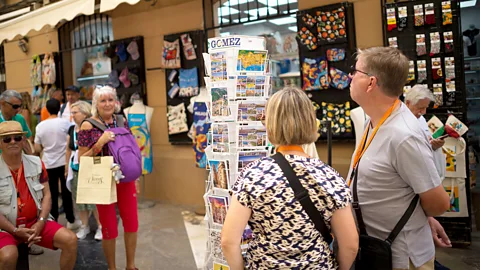 Getty Images
Getty ImagesThe BBC looks into the psychology behind travel souvenirs: why we buy them, their impact on local communities and the planet, and how we can shop more thoughtfully.
On a recent backpacking trip through the Himalayas, my bruises became the truest souvenirs. Three months later, many of the contusions remain – stubborn scars with no intention of fading. More personal than anything I could have bought, they carry a backstory only I can tell, and I know exactly where they came from, with no hidden costs to the planet or people. Perhaps that's why, over time, my desire for typical souvenirs has faded. I now value experiences over objects – looking for meaning in what I bring back rather than just another trinket.
But maybe that's just me. Two out of three Americans bring back a souvenir from their travels, with US sales topping $21bn (£16.7bn) in 2022. The souvenir industry has drawn criticism for its reliance on mass production and cultural appropriation. Still, it remains to be an often-overlooked side of tourism's impact. Frequent flyers face scrutiny, but trinket collectors rarely do. Innovative ways to preserve memories remain largely unrealised. And when a friend hands me a fridge magnet stamped with their latest destination, I cringe. What does it really mean to take home a piece of a place, and at what cost?
Humans have always had a penchant for collecting things. The Romans brought home spices, animal skins and rare artefacts to commemorate their travels and conquests. In the 18th Century, iconic locations like the Rome's Colosseum and Stonehenge in England were plundered by souvenir-seekers.
With the rise of industralisation and capitalism, a lot changed: the world became more connected, tourism boomed and profits took centre stage. But the human need to remember stayed. "Looking at a souvenir can bring back happy emotions as the brain links it to positive experiences," said Vaishnavi Madarkal, a psychologist and therapist based in India. "This connection can happen with anything – [whether it's] an object, music or a smell."
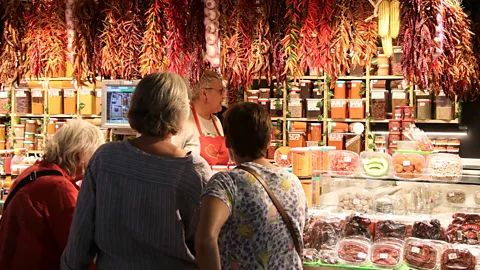 Tarang Mohnot
Tarang MohnotThe word "souvenir" comes from French, meaning "memory" or "remembrance". But the allure of souvenirs goes beyond memories. According to Madarkal, often it's the dopamine rush of retail therapy or cultural gift-giving norms. Take Japan's omiyage tradition, where travellers bring back small edible gifts for friends, family and co-workers. I, too, have picked up presents like saffron and pimentón in Spain or seaweed chips in Thailand, wanting to share my travels with loved ones.
For many, souvenirs go beyond tangible reminders and material gifts – they satisfy a deeper need to say, "I was there!" "At the core of our actions is a desire to feel heard, seen and validated," explains Madarkal. "The same holds for why we may buy souvenirs."
THOUGHTFUL TRAVEL
Want to travel better? Thoughtful Travel is a series on the ways people behave while away, from ethics to etiquette and more.
But how does this fit into a world already overwhelmed by excess? "The era of innocent tourism – where it was seen as a benign and universally positive force – ended around 2015," says Justin Francis, co-founder of Responsible Travel, a UK-based travel agency specialising in ethical tourism. "In Europe and America, protests against overtourism are growing. People are realising their vacations can leave lasting impacts on others' homes."
Yet, while travellers today are more aware of their impact, souvenirs have been somewhat left behind. With 25 years in the travel industry, Francis offers a macro perspective. "Though we haven't fully shifted yet, things have changed," he said. "I've often witnessed travellers examine products, and ask, 'Where did this come from?'"
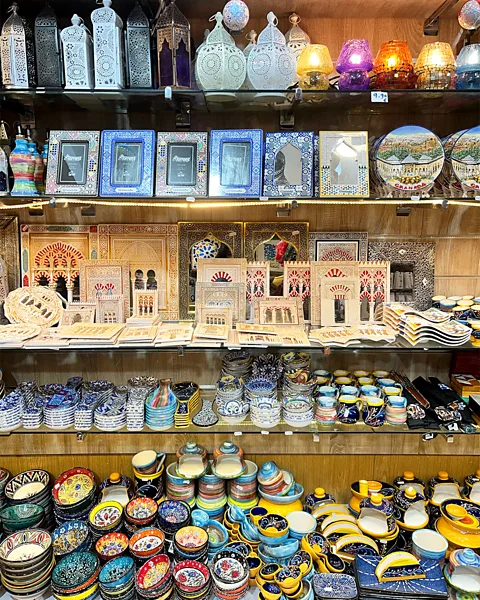 Tarang Mohnot
Tarang MohnotIn a world flooded with mass-produced items and fake markets, this question is crucial. A 2022 report by the Australian Government's Productivity Commission found that up to 75% of souvenirs marketed as "Indigenous" in Australia were counterfeit, with boomerangs and didgeridoos traced to Indonesia. Meanwhile, more than 70% of Thailand's popular elephant pants are made overseas. The battle of pashmina shawl artisans against cheaper, mass-produced alternatives is also well known.
"In the Leh market [in Ladakh, India], about 95% of fabrics sold as pashmina aren't genuine," says Sonam Angmo, co-founder of Lena Ladakh Pashmina, a slow textile brand focused on preserving the pashmina legacy while supporting local artisans. "[The fake fabric] is mass-produced in places like Ludhiana and Punjab then brought to Ladakh by outsiders."
A genuine pashmina shawl can cost upwards of 30,000 rupees (£280) due to the effort of raising goats in harsh climates and handcrafting the shawls. But for many travellers, this price is out of reach. As a result, some shops sell imitation shawls for 3,000-5,000 rupees (£27.4-£45.7), with most customers simply seeking a pashmina "bought in Ladakh" and giving little regard to its origins.
The high cost of genuine pashmina has driven demand for counterfeits, with the profitability of fake or "semi-pashmina" ensuring a steady supply. Angmo aptly calls this a "vicious cycle" that impacts local communities dependent on tourism. Frustrated by the difficulty of selling authentic items, some artisans resort to purchasing fake fabrics or working with mechanised looms. "It's how they feed their families," Angmo explains. This may create a dilemma for shoppers: while purchasing counterfeit goods might seem to support local retailers, the true cost is often borne by artisans who rely on time-honoured craftsmanship.
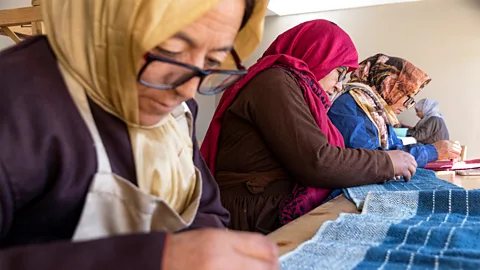 Lena Ladakh Pashmina
Lena Ladakh PashminaOne thing is clear: the desire to immortalise our travels isn't going anywhere. What's more, many communities, like those around busy tourist sites like Angkor Wat in Cambodia or Petra in Jordan, have thrived by turning souvenirs into a source of livelihood. Perhaps it's not about avoiding souvenirs entirely, but about making responsible choices.
It used to be easier to spot genuine local souvenirs. In places like Fez, Morocco, travellers could expect every leather good in the medina's souks to come from the city's iconic tanneries. But today's knockoffs are so sophisticated that even experts may struggle to distinguish them.
Besides, most souvenirs are small, portable and affordable – qualities that make them appealing. This explains why many of the world's most popular souvenirs fit this mould. Meanwhile, sellers are more aware of consumer mindfulness, often marketing items as "handcrafted" or "recycled", though the truth can be far from the label. When so many forces are at play, even the best intentions to be mindful and responsible can become difficult to uphold.
More like this:
• The new museum trend helping us regain our lost attention
So, how can you buy souvenirs that are ethical, sustainable and meaningful? Sonam and Francis both agree: ask questions. "Be curious… it's not just about buying or choosing carefully, it's about rejecting and explaining why," said Francis. "You could say, 'This sculpture is beautiful, but I'm concerned about its environmental impact.'"
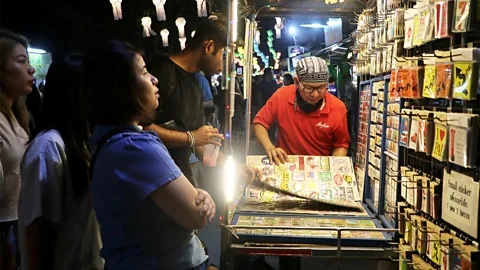 Tarang Mohnot
Tarang MohnotSrishti Tehri, a mindful traveller and content creator, emphasises being patient when souvenir hunting. She loves magnets for their daily visibility, but not just any magnet. "I try to find the most interesting ones and put them on my wall of fame – my fridge," she says. "I go the extra mile for unique designs or to support an artist. The generic ones are mostly ugly and feel like a scam." I agree. My rule: if every shop carries the same design, it's likely mass-produced.
Another way to ethically shop is to support reputable cooperatives and fair-trade markets. For instance, Women in Hebron features embroidered products and handicrafts by Palestinian women. Bangkok's Artist House, a centuries-old Thai wooden home, sells live portraits and wooden Muay Thai figurines and even offers opportunities to create your own souvenir.
Many countries now certify authentic local goods, too. In India, genuine pashmina shawls bear GI (Geographical Indication) tags; Australia uses the black-and-red Indigenous Art Code logo; and the Sámi Doudji label in Nordic countries guarantees items are made by Sámi artisans.
Intentions also matter. I no longer buy souvenirs on every trip – for myself or others. When I do, I ensure they're meaningful. Sometimes, I even ask friends what they want instead of guessing. Tehri echoes this: "I never buy the same thing for everyone. My love language shifts – some prefer something utilitarian; others love collectables."
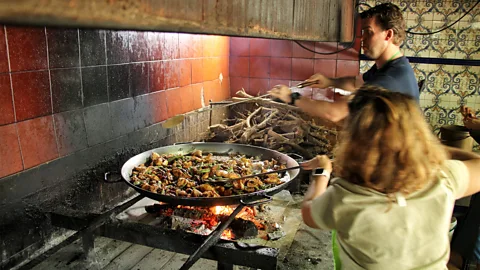 Tarang Mohnot
Tarang MohnotA good souvenir doesn't always have to be bought or tangible. When you think beyond "souvenirs" and more about what sparks memories, the possibilities get exciting. Maybe it's a letter sent from your destination, a well-kept travel journal, or even something salvaged – like beer caps or ticket stubs. Some travellers capture the sounds of their adventures while others take home tattoos. Join a cooking class, and you can take home a souvenir that keeps giving – new culinary skills.
Ultimately, there's no universal rule for what makes a "responsible" souvenir; it's a personal decision we each make. But next time you're grabbing a quick airport trinket or ticking off your gift list, pause and reflect.
"We live in a world of faceless transactions," says Francis. "If you think back to the Silk Road, trade was personal. You met the seller, exchanged something of value and that made the trade meaningful." Souvenirs, he believes, offer a chance to reclaim that intimacy. By buying directly from the maker, witnessing their craft and cutting out middlemen, you experience what Francis calls "the purest form of commerce".
--
If you liked this story, sign up for The Essential List newsletter – a handpicked selection of features, videos and can't-miss news, delivered to your inbox twice a week.
